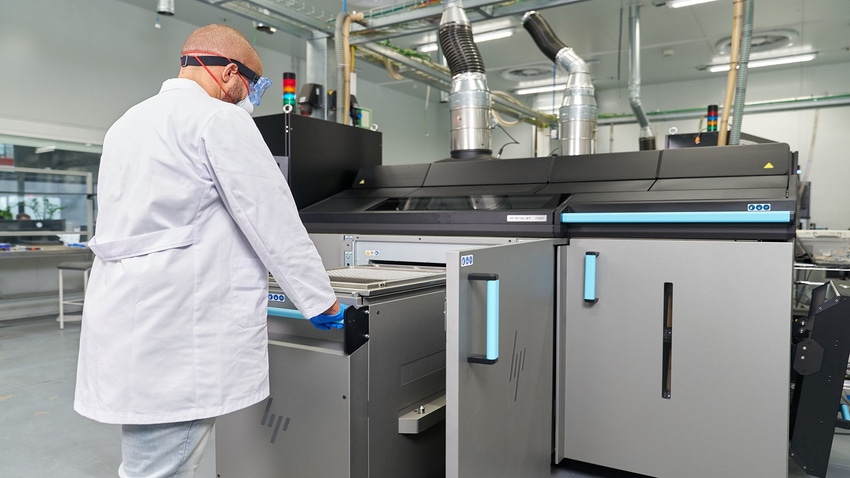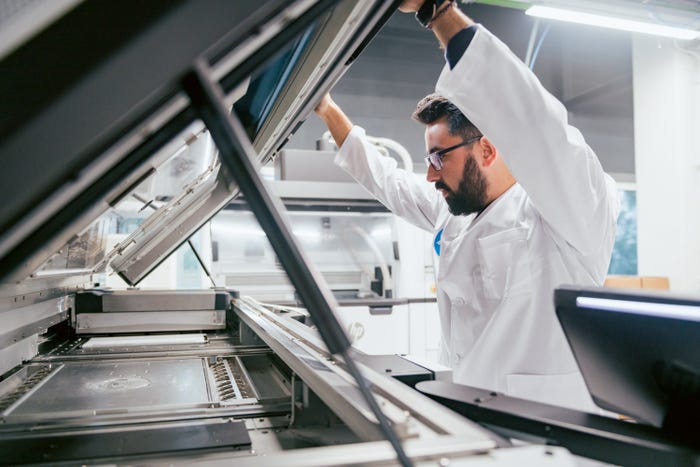Personalization Moves into Manufacturing Via 3DP
Consumer personalization is working its way into manufacturing, using 3D printing to change production methods.
December 15, 2023

At a Glance
- Mass customization
- 3D printing production
- Product personalization via 3DP
The holy grail of consumer products is personalization. If the technology permits, consumers can have products made to individual specifications. Sounds great, but it hasn’t been practical. Product costs come down with mass production. Technology has eluded the ability to offer personalization while taking advantage of mass production efficiencies. That’s changing.
3D printing is breaking the mold of mass-produced products. We’re seeing the beginning of mass customization. We caught up with Francois Minec, global head of polymers at HP Personalization and 3D Printing. The interview with Minec reveals advances in product personalization.
What do you see as the future of personalization?
Francois Minec: Personalization has emerged as a paramount concern for consumers, influencing not only purchasing decisions but brand loyalty. Given the current landscape, innovative technologies –
notably, those encompassed by Industry 4.0 – are being used to meet increased demands for personalization, ultimately expanding their footprint within the manufacturing space. These technological advancements and solutions, including 3D printing, are positioned to elevate personalization capabilities to unprecedented levels while simultaneously addressing inherent challenges in the manufacturing process, working in tandem with traditional manufacturing methods to achieve optimal outcomes.
With 3D printing, designs impossible to achieve with traditional tools can be brought to life, allowing adopters to bring novel applications to market, particularly in industries where delivering personalized products is essential. This shift towards 3D printing will impact all companies, regardless of their scale or industry, as they stand to reap the benefits of an enhanced capacity to provide personalized solutions. This also provides a unique opportunity to explore new avenues for growth and market differentiation. Ultimately, as industries increasingly recognize the transformative potential of 3D printing, the technology will play a pivotal role in reshaping the landscape of personalized solutions.

Under the lid of the HP Jet Fusion 5200 3D printing solution built specifically to enable high-volume production. HP.
Have you seen advances in personalization in 2023?
Francois Minec: 2023 marked a pivotal year for personalized manufacturing, especially in customer-centric industries, as we witnessed a surge in compelling applications of 3D printing. 3D printing’s capabilities in enabling personalization have already begun to reshape the manufacturing landscape, from customized medical solutions to consumer and sports products. These transformative applications mark the beginning of 3D printing’s impact on a future where personalization stands at the forefront of technological advancements across diverse industries.
The healthcare industry is one that has benefited from embracing 3D printing technology to achieve next-level, personalized medical solutions. For example, Mighty Oak Medical is leveraging HP’s Multi Jet Fusion 3D printing technology to enhance spinal fusion procedures, a traditionally difficult operation. Using its FIREFLY solution, which includes patient-specific pre-surgical planning guides and 3D-printed anatomical models, surgeons are able to more accurately drill and place pedicle screws, ensuring greater precision and patient safety. This personalized approach to spinal surgery not only improves operational efficiency but overall improves patient outcomes, all of which were made possible with 3D printing.
Similar results were achieved by Smith, who used HP’s 3D printing technology to offer snow sports lovers a truly custom goggle fit based on the individualized features of each user’s face with their I/O MAG Imprint goggle. Using a smartphone app, users can scan their faces and receive custom goggles that offer enhanced visibility by eliminating light leaks, air gaps, and hot spots. With the recent expansion of Smith’s Imprint 3D Technology with Squad and Squad XL winter frame offerings, high-quality, custom goggles are accessible at a lower cost, allowing even more consumers to experience hyper-personalization than ever before.
The HP Jet Fusion 5200 3D printing solution enables serial production and mass personalization with best-in-class speed and cost, and new features that enable better control job to job, and printer to printer. HP.
How will they continue in 2024?
Francois Minec: As we look to the future, the additive manufacturing industry will continue to advance in its ability to provide unique, differentiated solutions to old problems. When paired with an increased demand for personalized solutions among consumers across industries, efficient and speedy personalized manufacturing will continue to solidify as a standard to be met by companies in order to remain competitive in the market as opposed to a consumer preference. With the rapid development of AI and data analytics tools, innovative technologies will be used side by side to achieve a greater understanding of the manufacturing process and landscape, uncovering processes that will not only help companies achieve personalization, but also enable more businesses to do so at scale and on demand.
How does personalization play in the industrial space?
.jpg?width=700&auto=webp&quality=80&disable=upscale)
Mighty Oak Medical’s FIREFLY solution leverages HP’s Multi Jet Fusion technology to increase precision and safety, while reducing efficiency challenges common in spinal fusion surgery by providing surgeons with accuracy to-the-millimeter concierge pre-surgical planning done in 3D on virtual renderings of patients’ spines. HP.
Francois Minec: Personalization can play a significant role in the industrial sector by maximizing efficiency and quality while keeping up with ever evolving consumer needs and preferences. By assuming a personalization-driven mindset to production, companies seek techniques and tools that together make up an extremely agile production model, one that minimizes costs and challenges tied to inventory, warehousing, transportation, and waste.
3D printing is one of the key enablers of hyper-personalized production. As an inherently flexible tool that enables quick and cost-effective short runs, manufacturers require less machinery for manufacturing. Additionally, the technology allows for personalized product designs to be stored digitally, enabling more centralized, local production, which ultimately reduces lead times compared to those of traditional production lines. Minimal reliance on the supply chain ensures a consistent rate of personalized production despite costly or challenging external conditions.
It is important to recognize that by placing personalization at the forefront of one’s manufacturing process, companies are shaping the future of the industrial sector, introducing innovative Industry 4.0 technologies that will drive production strategies for years to come.
What advances have you seen in 3DP over the past year?
Customized Smith I/O MAG IMPRINT goggles, named one of TIME Magazine’s best inventions of 2022, allow consumers to scan their face using Smith’s smartphone app and receive a made-to-order pair of goggles that match their exact facial contours to protect from the elements. The goggle’s frames are 3D printed using HP’s Multi Jet Fusion platform all in just 14 business days. HP
Francois Minec: It has been a momentous year for the 3D printing industry, with the adoption of the technology spanning global markets and reaching exciting new industry verticals. We do not have to look far to see 3D printed products and parts in the mainstream disrupting industries, helping us run faster, drive smoother, heal better, and so much more. Innovators large and small are investing in the technology to reshape their manufacturing production lines in favor of increased production speed, design flexibility, resilience, and even sustainability.
Much of this can be attributed to technological advancements, which have made 3D printing economically viable compared to traditional manufacturing methods, reaching a new level of maturity that extends beyond prototyping and into mass-scale commercial production. Automating steps along the workflow, for example, has been key to overcoming complexities associated with scalability, improving productivity and quality, and reducing costs. When downtime and dependence on human labor is reduced, manufacturers can shift production into traditionally costly nights or weekend shifts to increase product output and productivity while driving the total cost of ownership down.
AI-enhanced simulations and other software capabilities have also been vital to reducing barriers to entry, accelerating part development, and scaling production. When considering the completely different set of design skills needed to bring breakthrough 3D printed applications to market at speed compared to traditional manufacturing methods, access to these types of capabilities as built-in or add-ons to commercial scale printers can really close the adoption gap for mid-to smaller-size companies.
What can we expect to see in 2024?
Francois Minec: From material development and product design, right through to production, the crafty use of AI and data analytics is improving 3D printing, allowing it to increasingly challenge an antiquated manufacturing industry and fulfill the promise of industry 4.0.
The best part is that we have only scratched the surface of what is possible when we pair industry-leading 3D printing technology and increasingly powerful AI. We expect to see the deployment of sophisticated AI models to help product designers and even those without design expertise become more proficient in designing for 3D manufacturing. Not only will this help retain and attract talent—a resource the manufacturing industry is currently experiencing a shortage in—it will also allow us to meet the demand for hyper-personalization and more sustainable products.
From a printing optimization and predictive standpoint, physics simulations will be beneficial to AI, allowing insights to be gleaned without the need for physical printing to take place. The result: improved control process and a reduction in errors and variation of printed products, which vastly increases the yield of production runs and allows additive manufacturing to increasingly challenge traditional injection mold manufacturing.
Where do you see 3DP going beyond 2024?
Francois Minec: I am excited about the promise of digital twins, which represent a virtual replica of 3D printers and their operations. Digital twins will one day allow us to monitor, analyze, adjust, and optimize printing processes and parameters to ensure a continuous, automated, and efficient 3D printer operation. There are many benefits to this type of insight, with a reduction in errors and maximization of uptime independent of human intervention at the top of the list. “Lights out” factories as a concept is within reach with this revolutionary technology, allowing manufacturers to expand production beyond the typical constraints of labor costs.
Prioritizing efficiency and productivity in this way has helped us inch closer to embracing industry 4.0 and will continue to do so as the adoption of 3D printing and other innovative manufacturing technologies becomes more widespread. Looking beyond 2024 and into the next industrial revolution—industry 5.0—the emphasis will shift towards resilience, sustainability, and human centricity. This calls for the convergence of a highly skilled workforce and cutting-edge robots to work side-by-side. For that to happen, manufacturers must be focused today on reskilling and training the workforce to not only oversee the operation of these new technologies but also maximize the potential for innovation in design and production.
About the Author(s)
You May Also Like





